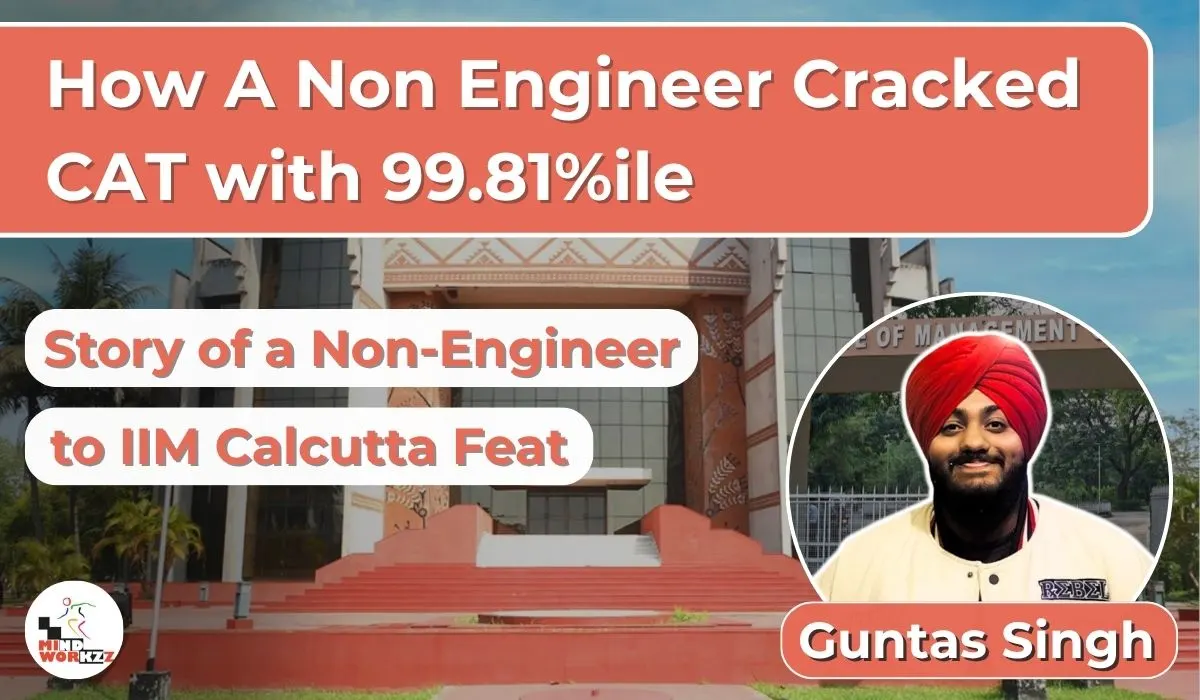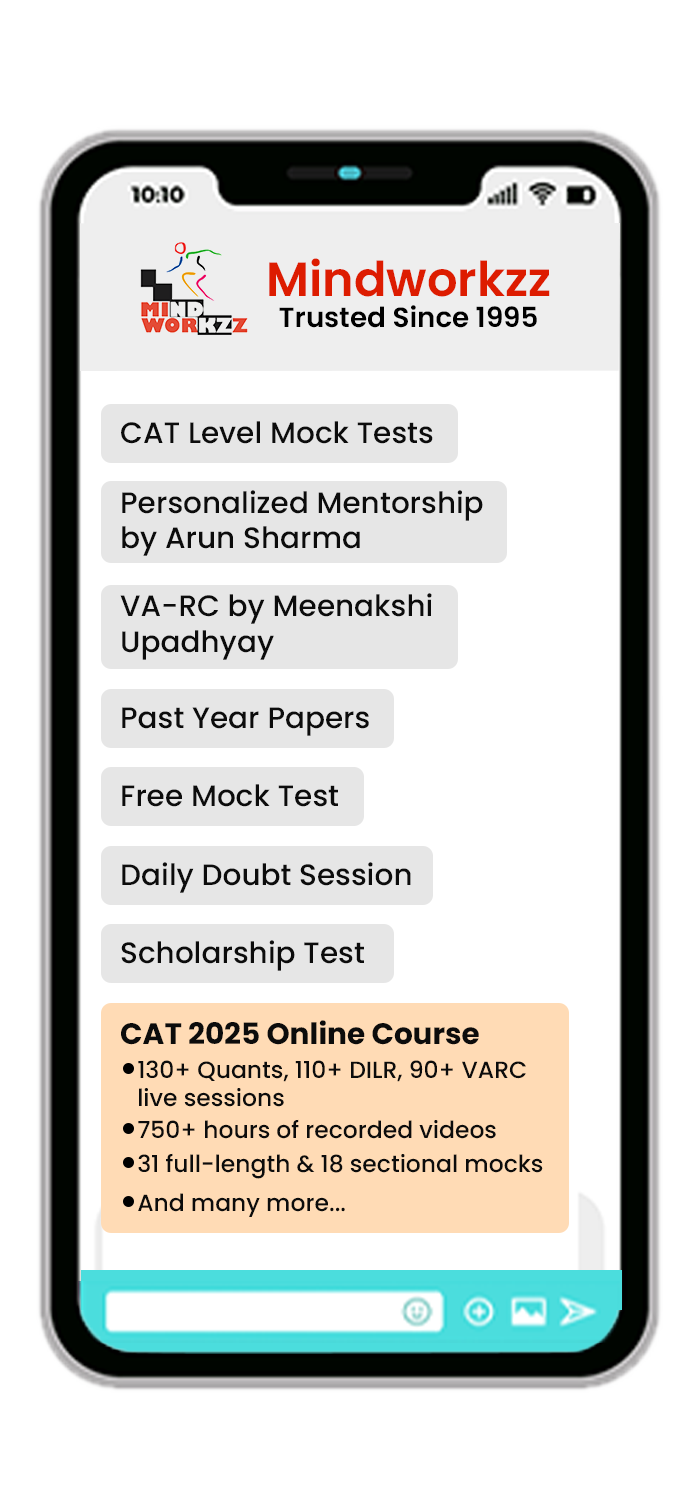It is rightly said, “Success is not final, failure is not fatal: it is the courage to continue that counts.”
One such story that beautifully mirrors this quite is the story of Guntas, who cracked the CAT with an exceptional 99.81 percentile and secured a seat in the prestigious IIM Calcutta. What makes his journey more inspiring is not just the destination but the odds he overcame to get there. Coming from a non-engineering background, he faced significant challenges especially in the Quants section, which is often dominated by candidates from technical streams. However, instead of succumbing to fear and self-doubt, he channelled his energy into building strong fundamentals, maintained an optimistic mindset, and challenged himself to overcome his weakness.

his story is a shining example of how belief in oneself, structured efforts, and a resilient mindset can turn any dream into reality. His journey proves that where you come from doesn’t define your potential-your persistence does.
Here’s the interview of Guntas, who cracked the CAT exam with a stellar 99.81%ile, overcame his fear of Quant despite coming from a non-mathematics background, and proudly converted IIM Calcutta – proving that dedication and mindset can conquer any challenge.
1. Who is Guntas and What was the ultimate goal?
Guntas is a self-driven and ambitious person who set his sights on cracking the CAT exam with excellent marks and securing admissions to one of the India’s prestigious institutions IIMC (Indian Institute of Management – Calcutta). Coming from a non-engineering background (non-mathematics), his journey was filled with academic and personal hurdles, especially in the section of quantitative aptitude. However, with constant efforts, courage, dedication, and self-discipline, he managed to achieve his dream. His inspirational story is a powerful example of how consistent efforts and dedication with right mindset can help to overcome any limitations.
2. How did Guntas felt after converting IIM Calcutta? Let’s have a walk through his emotions and thoughts during that transition?
Guntas described this feeling as wholesome and overwhelming liberating. He expressed a deep sense of happiness and relief, saying he did not feel this much free in nearly two years. The stress and pressure that had built up during the preparation journey finally listed and the achievement validated all the sacrifices he made. For him it was not just about scoring good and getting into a prestigious institution, it was more about overcoming his obstacles and make his dream come true.
3. What initially inspired Guntas to pursue career in finance and the CFA certifications?
His fascination with finance was sparked during his teenage years, heavily influenced and inspired by popular shows like Suits and Billions, which glorify high-staked business environments. These shows planted the seeds of interest in him, but it was an introductory finance program at IIM Bangalore that cemented his passion. That programs exposed him to real-world finance concepts and gave him taste of what career in finance would look like. Inspired by this, he decided to pursue CFA certification to deepen his knowledge and improve credibility in the field.
4. When did Guntas begin his CAT preparation and how did he structure his study plan efficiently?
He started preparing seriously around May or June 2023. Despite being intimidated by mathematics, he enrolled in a local coaching institute to build his basics. Instead of obsessing over fixed study hours, he adopted a more flexible and effective strategy- target-based focused learning. On average, he studied 6-7 hours per day, focusing on mastering concepts and individual topics across all the three sections. He emphasized practice over perfection, working through various sets and gradually improving his testing skills without the pressure of time constraints initially.
5. What study strategy did Guntas find most effective for his learning style?
Rather than tracking the number of hours he studied, Guntas preferred setting specific performance targets and made sure to complete it each day. For example, he would aim to improve accuracy in a particular topic or increase his mock test scores in a section. This results-driven approach allowed him to measure real progress rather than just ticking off time. It also helped him to stay encouraged, motivated as small achievements reinforced his confidence. He states that what matters the most it how effectively ad purposefully you study and not how long you study.
6. What are the major challenges Guntas encountered during his CAT journey?
Quantitative Aptitude was his highest challenge due to his non-math academic background. Initially, the subject caused a lot of self-doubt and anxiety. However, he made a very conscious decision of not to let fear dominate his preparation. He focused on slowly building up the concepts from ground level, regularly reviewing and practicing from mistakes. What helped him the most was his optimistic attitude – he never allowed failures to affect his long-term determination.
7. What did Guntas learn from his earlier interview attempts at XLRI and FMS?
His interviews at XLRI and FMS were valuable learning experiences. Guntas admitted that he made some random mistakes – such as interrupting the panellists’ mid-question and being overly critical while answering sensitive topics. These mistakes helped him reflect on his communication style and emotional intelligence during the interviews. He learned the importance of humility, patience and being mindful of the body language. These lessons prepared him well for IIM Calcutta interview, where he showed more maturity and clarity of thought that eventually led to give good responses.
8. What made the IIMC interview process stand out for Guntas?
He was deeply impressed by the professional and empathetic conduct of the IIMC interview panel. Despite it being an early interview, the institute provided and thoughtfully arranged food and refreshments for candidates. The panellists themselves were very humble, approachable, and made the candidates very comfortable. Instead, of grilling him, they facilitated a natural and engaging conversation which allowed him to express himself confidently.
9. What was the most challenging and thought-provoking questions he faced during his IIMC interview?
One of the most memorable and thoughtful questions posed to him was: Why finance and not defence? – especially since he spoke passionately about thriving in high-stakes environments. It was a curveball that required him to quickly introspect and articulate a nuanced answer. Additionally, the panel asked him to reflect on Punjab’s complex history with the defence sector, tying his background into the questions. It tested his awareness of socio-political context and personal narrative.
10. Were there any technical finance questions asked during the interview?
Yes, but instead of delving into hardcore mathematics or statistical problem, the panel focused on conceptual understanding and application. They discussed the topics like foreign portfolio investments, zero-coupon bonds, and even touched on current geopolitical tensions affecting trade and tariffs. These discussions tested his grasp of real-world financial systems. Although, he couldn’t answer one specific question about structuring a butterfly payoff with long call options, he handled other technical questions confidently and honestly acknowledge where his knowledge had gaps.
11. What is Guntas key advice for future CAT aspirants?
He strongly advises candidates to ‘’shut out the noise’’. With so many online forums, YouTube videos, and social media groups flooding aspirants with conflicting advices. It is easy to get overwhelmed and lose focus. Guntas recommends staying grounded, listening to experienced mentors, and filtering information carefully. Building a peer group that motivates you and challenges you is crucial. He stresses the importance of mock tests but adds that it’s the quality of feedback and self-analysis that truly enhances performance.
12. What kind of mindset does Guntas believe is essential for CAT preparation?
A focused and self-aware mindset. According to him, CAT is not just a test of aptitude, but also of patience, emotional control, and discipline. Candidates should focus on their own journey, avid comparisons and commit to continues improvement. It’s vital to believe in one’s ability to improve, to take failures in stride, and to adapt strategies as needed. Listening to mentors, staying honest about weaknesses, and maintaining balance in life can make the preparation process more meaningful and successful.
Final Words
Guntas story is a blend of ambition, humility, and perseverance. From doubting his maths skills to confidently handling technical finance questions, his growth is both inspirational and practical. His insights offer valuable guidance to aspirants preparing for CAT or any other competitive exam- and his journey reminds us that no background too weak if the determination is strong.




